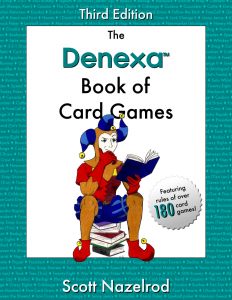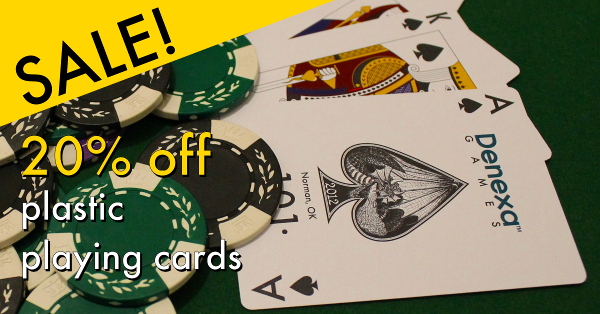Chicago
Chicago (not to be confused with the Low Chicago rule that is sometimes added to Seven-Card Stud games) is a unique game for two to four players. In Chicago, players form the best poker hand they can through a few rounds of Draw Poker-style play. Then, they use these cards to play through a trick-taking game. However, the only trick that matters for scoring purposes is the last one!
Despite bearing the name of an American city, Chicago is a Swedish game. It first gained popularity in Östergötland province in southern Sweden. From there, it spread throughout the country.
Object of Chicago
The object of Chicago is to be the first to score 52 points. Players score points by having the best poker hand, and by capturing the last trick.
Setup
To play Chicago, you’ll need a standard 52-card deck of playing cards. Make sure you never have to worry about beaten-up or dirty cards by always playing with a deck of Denexa 100% Plastic Playing Cards. You also need something to keep score with, such as pencil and paper, or a smartphone scorekeeping app.
Shuffle and deal five cards to each player. The remainder of the deck becomes the stock.
Game play
First draw and showdown
The player to the dealer’s left goes first. They may discard any number of cards, from zero to five. They keep these discards face down, and placing them in a discard pile in the center of the table. The dealer then deals the player the same number of cards they discarded, bringing them back to a five-card hand. The next player to their left then has the chance to discard as well, and so on around the table to the dealer.
After all players have had a chance to draw new cards, the player to the dealer’s left may declare that they hold a poker hand of at least a pair or better. Initially, they name only the type of hand they have, not the rank of the cards. If the player does not have at least a pair, or they do not wish to disclose the content of their hand, they may pass. The next player to the left may then declare a higher poker hand, or likewise pass. This continues on around the table.
If a player holds a poker hand of the same type previously declared by a previous player, the first player must declare the rank of the relevant cards (for example, “two pair, kings high”). The other player may then pass or declare a higher combination. If the combinations remain tied, they continue going back and forth until one of the two passes, or it is established that the combinations are in fact equal.
Note that the showdown is conducted entirely through verbal declarations. At this point, nobody reveals their hand to the other players.
Once it has been established who holds the highest poker hand, that player scores as follows:
- Royal flush: 52 points
- Straight flush: 8 points
- Four of a kind: 7 points
- Full house: 6 points
- Flush: 5 points
- Straight: 4 points
- Three of a kind: 3 points
- Two pair: 2 points
- One pair: 1 point
If two players tie for the highest poker hand, nobody scores for that showdown.
Second draw and showdown, and third draw
After the first showdown has been settled, the players then go through another drawing phase, conducted the same way as before. If the player (or players) holding the highest poker hand in the previous round wishes to discard any of the cards used to form that hand, they must expose all five of their cards to the other players to prove that they indeed held that combination.
After the second drawing round, a second showdown takes place. After that, players draw for a third and final time. No showdown takes place after this draw, however.
If, at any time, the stock is depleted, the discard pile is immediately shuffled to form a new stock.
Trick play
After the third drawing round, the player to the dealer’s left leads to the first trick. Each player in turn plays a card to the trick. A player must follow suit, if possible; if they cannot, they may play any card. The player who plays the highest card of the suit led wins the trick, and leads to the next one.
As tricks are played, rather than collecting them into won-tricks piles, as is common in other games, the cards are left face up on the table in front of the person who played them. This allows the hands to remain easily identifiable for end-of-hand scoring.
The player who captures the fifth and final trick scores five points for doing so. The player holding the highest poker hand at the end of the hand scores for it, as above.
Ending the game
The cards are then collected, and the deal passes to the left for the next hand.
When a player starts a hand with 46 or more points, they are no longer allowed to discard cards and draw replacements. They must play the hand all the way through with the cards they started with. Note that if a player reaches 46 points in the middle of a hand, this restriction does not apply until the start of the next hand.
Game play continues until one or more players reach a score of 52 or more points. The player with the highest score at the end of that hand wins the game.
Penalties
Should a player declare a poker hand that it cannot be proven they actually held, because it is not present after the trick-taking and they did not reveal it prior to discarding cards, that player forfeits the game.



